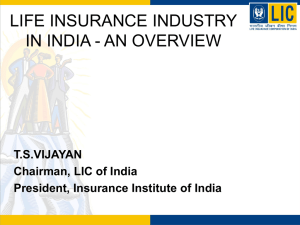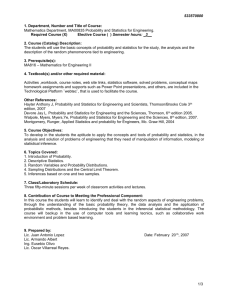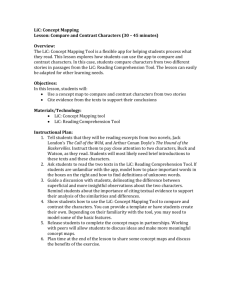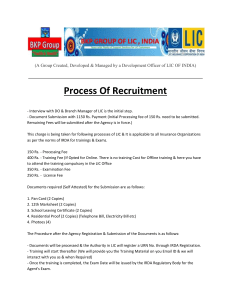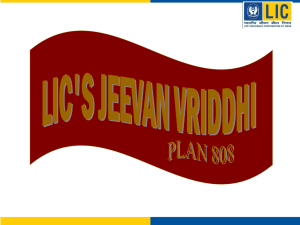LIC India: Company & Area Profile - Chapter Overview
advertisement
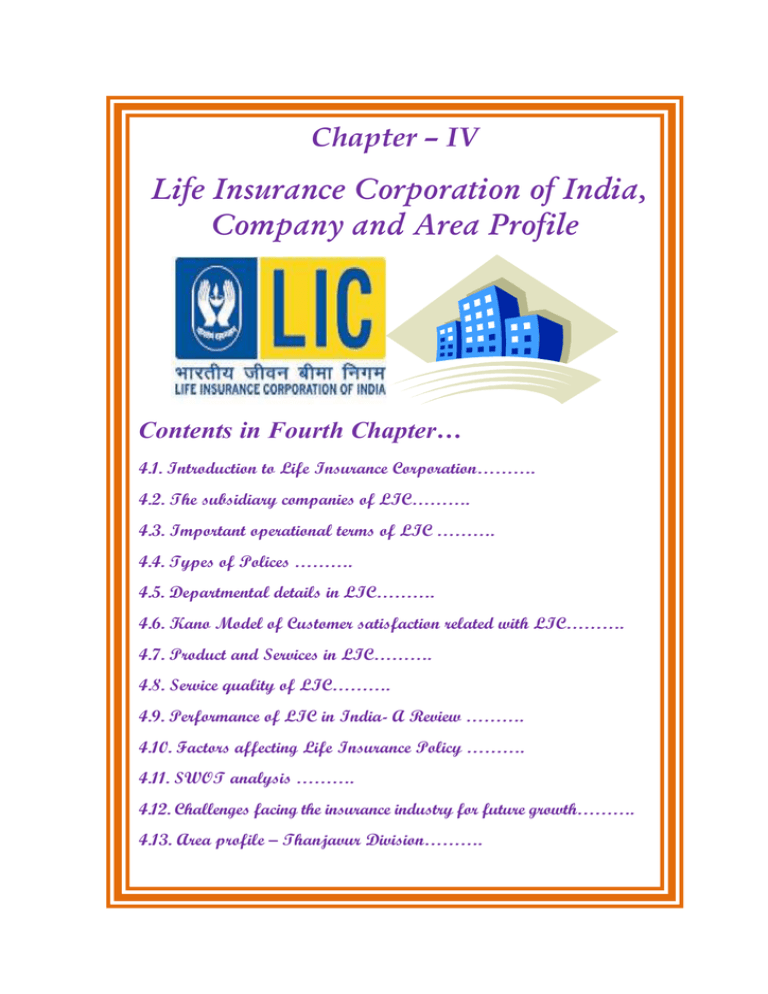
Chapter – IV Life Insurance Corporation of India, Company and Area Profile Contents in Fourth Chapter… 4.1. Introduction to Life Insurance Corporation………. 4.2. The subsidiary companies of LIC………. 4.3. Important operational terms of LIC ………. 4.4. Types of Polices ………. 4.5. Departmental details in LIC………. 4.6. Kano Model of Customer satisfaction related with LIC………. 4.7. Product and Services in LIC………. 4.8. Service quality of LIC………. 4.9. Performance of LIC in India- A Review ………. 4.10. Factors affecting Life Insurance Policy ………. 4.11. SWOT analysis ………. 4.12. Challenges facing the insurance industry for future growth………. 4.13. Area profile – Thanjavur Division………. 73 CHAPTER - IV LIFE INSURANCE CORPORATION OF INDIA, COMPANY AND AREA PROFILE 4.1. Introduction to Life Insurance Corporation (LIC) The Life Insurance Corporation of India popularly known as “LIC of India” was incorporated on September 1, 1956 by nationalizing 245 Indian as well as foreign companies. It was established 52 years ago with a view to provide an insurance cover against various risk in life. The luminaries who spearheaded this move at that time visualized an entity that will provide life insurance to Indians, especially the vast rural people, at an economical cost and channel the savings for the betterment of the nation. It is the largest life insurance company in India and also the countries largest investor. It is fully owned by the Government of India and headquarter is Mumbai. Today LIC function with 2048 fully computerized branch offices, 100 divisional offices, 7 Zonal offices and the corporate office. LIC’s wide area Network cover 100 divisional offices and connects all the branches through a Metro area network. LIC has tied up with some Banks and service providers to offer on- line premium collection facility in selected cities. LICs ECS and ATM premium payment facility is an addition to customer convenience. Apart from on-line kiosks and IVRS, info centers have been commissioned at Mumbai, Ahmedabad, Bangalore, Chennai, Hyderabad, Kolkata, New Delhi, 74 Pune and many other cities. With vision of providing easy access to its policyholders, LIC has launched its SATELLITE SAMPARK offices. The digitalized record of the satellite offices will facilitate anywhere to serve and other convenience in the future. LIC has crossed many milestones and has set unprecedented performance records in various aspect of life insurance business. The same motives which inspired our forefathers to bring insurance into existence in this country inspire us at LIC to take this message of protection to light the lamps of security in as many homes as possible and to help the people in providing security to their families. 4.2. The subsidiary companies of LIC 4.2.1. LIC of India, International A joint venture offshore company promoted by LIC, commenced its operation in july1989. The primary objective is to the US-dollar denominated policies which cater to the insurance needs of non-resident in Indians. It provides insurance services to policyholders who residing in Gulf. The LIC International operates in all Gulf Cooperation Council (GCC) countries. 4.2.2. LIC Nepal A joint venture company formed in September 2001 with the Vishal Group of Industries with a capital base of Rs.250mn. It is one of the largest capitalized insurance companies of Nepal. It has joint share between LIC of India (55%) Vishal Group (25%) and has a public participation to the extent 20%. 75 4.2.3. Life Insurance Corporation Lanka Limited (LICL) A joint venture company formed in 2003 with the Bartleet Group of Companies, it is one of the oldest and reliable institutions in Sri Lanka. The combined strengths of these two formidable companies has enabled LICL to emerge as the premier provider of Life Insurance in Sri Lanka. The Indian-based bluechip also has offices in UK, Mauritius, Fiji, and in all Middle East countries. 4.2.4. LIC Housing Finance Incorporated on June 19, 1989; its main objective is to provide long term finance for construction or purchase of houses or apartments. The company provides long terms finance to individuals for purchase, construction, repair and renovation of new \ existing flats \ houses. It also provides finance on existing property for business, personal needs and gives loans to professionals for purchase or construction of clinics \ nursing homes \ diagnostic centers \ office space and also for purchase of equipments. It has set up a representative office in Dubai and Kuwait to cater to the non- resident Indians in countries covering Bahrain, Dubai, Kuwait, Qatar and Saudi Arabia. It has client group of over 9,40,000 prudent house owners who enjoy the company’s financial assistance. 4.2.5. LIC Housing Finance Limited Care Homes It is a Wholly-owned subsidiary of LIC Housing Finance. It builds and operates “Assisted Community Living Center” for senior citizens. It operates a network of approximately 6 regional offices, 13 back offices, and 127 marketing offices. 76 4.3. Important operational terms of LIC (i) What Is Life Insurance? Life insurance is a contract that pledges payment of an amount to the person assured (or his nominee) on the happening of the event insured against. The contract is valid for payment of the insured amount during i. The date of maturity, or ii. Specified dates at periodic intervals, or iii. Unfortunate death, if it occurs earlier. (ii) Why We Need Insurance Life insurance is a contact by which you can protect yourself against specific uncertainties by paying a premium over a period. Since each of us during our life faces with numerous risks-falling health, financial losses, accident and even fatalities. (iii) Protection You need life insurance to be there and protect the people you love, making sure that your family has a means to look after itself after you are gone. It is a thoughtful business concept designed to protect the economic value of a human life for the benefit of those financially dependent on him. (iv) Retirement Life insurance makes sure that you have regular income after you retire and helps you maintain standard of living. It can ensure that your postretirement years are spent in peace and comfort. 77 (v) Savings and Investments Insurance is a means to Save and Invest. Your periodic premiums are like Savings and you are assured of a lump sum amount on maturity. A policy can come in handy at the time of your child’s education or marriage! Besides, it can be used as supplemental retirement income. (vi) Tax Benefits Life insurance is one of the best tax saving options today. Your tax can be saved twice on a life insurance policy-once when you pay your premiums and once when you receive maturity benefits. Money saved is money earned. (vii) Myths of Insurance i) Insurance is just meant for saving tax. ii) Insurance does not give good returns iii) Insurance products are not flexible (viii) Indemnity Legal principle that specifies an insured should not collect more than the actual cash value of a loss but should be restored to approximately the same financial position as existed before the loss. (ix) Premium Premium is the consideration that the policyholder has to pay in order to secure the benefits offered by the insurance policy. It can be looked upon as the price of the insurance policy. It may be a one-time payment or periodical 78 payment (Monthly Quarterly, Half yearly, Yearly). A default in premium can endanger the continuance of the policy. If that happens, the policy will be treated as lapsed and the expected benefits. (x) Claims A claim is the demand that the insurer should redeem the promise made in the contract. The insurer has then to perform his part of the contract i.e. settle the claims, after satisfying himself that all the conditions and requirements for settlement of claim have been complied with. (xi) Agent An insurance company representative licensed by the state, who solicits, negotiates or effects contracts of insurance, and provides service to the policyholder for the insurer. Assurance is the coverage of risk on the happening of an event, which will happen during the period of insurance. Insurer is the company, which covers the risk under a policy of insurance. Insured is the person on whose life the risk is covered. Proposer is the person who seeks the insurance on the life proposed for insurance Proposal is the offer document filled and signed by the proposer indicting interalia the past & present health of the life to be assured, the amount for which he desires to have the life to be insured, the period for which he wants to have the insurance and the specified plan. 79 Plan of insurance is the scheme offering specified benefits. Different plans are offered by the insurer to suit the varying need of the insuring public. Term is the period (no. of years) for which the risk on the risk on the life assured will be covered. Sum assured is the amount payable on the happening of the even specified in the policy during the term of the policy. Survival benefit is the amount (a fixed percentage of sum assured) payable under certain plans on the life assured surviving the period specified in the policy. Policy is the document issued by the insurer specifying the sum assured, plan, term, the benefits payable under the policy and the conditions and privileges of the policy. It is an evidence of the contract of life insurance. Tabular premium is the amount of premium per thousand sum assured indicated in the table of rates for various plans and for different ages and terms. Maturity claim is the payment of amount by the insurer on the life assured surviving the term specified in the policy. First Premium Receipt is the document issued by the insurer, as a prelude to the issue of the policy to indicate that he has accepted the risk on the life proposed for insurance. Date of commencement (DOC) is the date month and year from which the risk commences under a policy. 80 Days Of Grace is Policy holders are expected to pay premium on due dates. a period is 15-30 days is allowed as grace to make payment of premium; such period is days of grace. Due date is the date on which the installment premium to be paid under the policy falls due. Nomination is the facility available under a life insurance policy to enable the insurer to pay the benefits available under the policy to the nominated person on the death of the life assured. Assignment is the transfer of rights under the policy. Non- Medical scheme proposals submitted for life insurance will be considered for acceptance without medical examination by the authorized medical examiner. Medical Scheme proposals submitted for life insurance will be considered only on the strength of the Medical Report submitted by the authorized medical examiner of the insurer. Bonus is additions made to the sum assured under with profit policies as at the end of each financial year as a result of an investigation made by an actuary into the working of the life insurance company. With profit policies; is which are entitled to have a share of the surplus arrived at as a result of the investigation mentioned above. Without profit policies; is which are not entitled to have a share of the surplus. 81 Surrender; premature termination of the contract of life insurance by the life assured. A policy can be surrendered if there full years premiums have been paid. The amount paid on surrender is called surrender value. Rider; is additional benefits granted by insurers under a standard plan of insurance by payment of additional premium by the insured. Insures offer rider such as increased death cover (term insurance), Medical insurance (providing relief for certain serious aliments or for undergoing certain major operation) and accident cover. IRDA has stipulated that the premium collected for these extra benefits (riders) should not exceeds 30% of the tabular premium. 4.4. Types of Policies 4.4.1. Introduction The Researcher, found the different types of Life Insurance Plans in the market. As we know that Life Insurance is important for everyone to protect family incase of their demise the insured money will save their family for educating their children and marriage etc. According to your needs, one can choose Life Insurance Scheme of any form. 4.4.2. Term Insurance Policy This policy is pure risk cover with the insured amount will be paid only if the policy holder dies in the period of policy time. The intention of this policy is to protect the policy holder’s family incase of death. For example, a person who takes term policy of Rs.500000 for 20 years, if he dies before 20 82 years then his family will get the insured amount. If he survive after 20 years then he will not get any amount from the insurance company. It is the reason why term policies are very low cost. So, this type of policy is not suitable for savings or investment. 4.4.3. Whole Life Policy As the name itself says, the policy holder has to pay the premium for whole life till his death. This policy doesn’t address any other needs of the policy holder. Because of these reasons this kind of policy is not very popular or insurance company not suggesting to take this policy. 4.4.4. Endowment Policy It is the most popular Life Insurance Plans among other types of policies. This policy combines risk cover with the savings and investment. If the policy holder dies during the policy time, he will get the assured amount. Even if he survives he will receive the assured amount. The advantage of this policy is if the policy holder survives after the completion of policy tenure, he receives assured amount plus additional benefits like Bonus, etc. In this kind of policy, policy holder receives huge amount while completing the tenure. In addition to the basic policy, insurers offer various benefits such as double endowment and marriage/ education endowment plans. The cost of such a policy is slightly higher but worth its value. 83 4.4.5. Money Back Policy Money Back Policy is to provide money on the occasions when the policy holder needs for his personal life. The occasions may be marriage, education, etc. Money will be paid back to the policy holder with the specified duration. If the policy holder dies before the policy term, the sum assured will be given to his family. A portion of the sum assured is payable at regular intervals. On survival the remainder of the sum assured is payable. 4.4.6 Annuities and Pension An annuity is a series of periodic payments. An annuity contract is an insurance policy, under which the annuity provider (insurer) agrees to pay the purchaser of annuity (annuitant) a series of regular periodical payments for a fixed period or during someone's life time. In an annuity, the insurer agrees to pay the insured a stipulated sum of money periodically. The purpose of an annuity is to protect against risk as well as provide money in the form of pension at regular intervals. Over the years, insurers have added various features to basic insurance policies in order to address specific needs of a cross section of people. 4.5. Departmental details in LIC The organization having a such a huge size has to have a well defined hierarchical structure and LIC is not an exception to this fact. A well defined proper organization structure with officials with exact knowledge of their 84 duties is a must for an organization to prosper. LIC has a vast network offices across the country and abroad so it has defined and maintained its organizational structure in the following way. LIC has its main central head office at ‘Yogaakshema’ Jeevan bima marg at Mumbai. Then it is followed by eight zonal offices namely central zone, eastern zone, east central zone, northern zone, north central zone, southern zone, south central zone, western zone respectively. After these eight zonal offices there are several divisional offices under each zonal office and these divisional offices are mostly in each big city. At last comes the branch office and there are several branch offices under each divisional office. At all the branch offices there is a branch manager and several departments and the major function of these branch offices is sales and servicing of the policies. In a branch office the top most is a branch manager and under his control seven different departments with each of these departments functioning independently to each other. These seven departments are as follows 85 Chart - 6 Departmental details in LIC Zonal Office Divisional Office Branch office Sales Department Claims Department New Business Department Office Service Department Accounts Department Micro Department Policy Service Department 86 Sales Department This department is mainly concerned with the sale of new policies and is headed by Assistant Branch Manager Sales (ABMS). The internal agent of LIC is the Development Officer who has the job of communicating and training the Free Lancing agents. It is the development officer who continuously encourages the agents to get new business and the income, performance and commission through policy selling comes under the jurisdiction of this department. New Business Department This department performance the very important function of underwriting new policies which are sent to it for authentication. It checks that all the information provided by the customer is true and the proposal form and all other details and proofs are legal. After scrutinizing the new policy it issues the first premium receipts (FPR) and then issues the policy bond. If anything is found insufficient the proposal form is sent back to the sales department to correct the mistake and again submit it. Policy Service Department After the policy bond is issued, the case is passed on to this department to look after sales service of the policy. It takes care of the premium dates and if the policy is lapsed then its revival is done by this department. Also if any loan is required by the customer against his/her policy then its approval has to be given from the policy service department only. 87 Accounts Department It is responsible for processing of all the cheques and loans which come to it. The details regarding financial aspects are covered under this department. Claims Department All types of claims i.e. survival benefit claim, maturity claim and death claim are settled by this department. In case of death claim if death occurs after three years then no investigation is involved in the settlement process and if it occurs before three years then proper investigation is done and the claim is considered to be an early claim case. Micro Department This department has all important function of co-ordinating with each department. Each day’s business is collected and its four copies are made and one copy is sent to the divisional office, second is submitted to the branch manager, third remains with the in charge of micro department and fourth in the branch office. Office Service Department This department takes care of all miscellaneous tasks of office and dispatch of cheques, loans etc come under the responsibility of this department. 88 4.6. Kano Model of Customer Satisfaction related with LIC The Kano et al. (1996)1 model of customer satisfaction classifies product attributes based on how they are perceived by customers and their effect on customer satisfaction (Kano, Seraku et al., 1996). According to the model, there are three types of product attributes that fulfill customer satisfaction to a different degree 1) Basic or expected attributes, 2) Performance or spoken attributes, 3) Surprise and delight attributes. A competitive product meets basic expected attributes, maximizes performances attributes, and includes as many “excitement” attributes as financially feasible. In the model, the customer strives to move away from having unfulfilled requirements and being dissatisfied 1 Kano, N., N. Seraku, et al. (1996), "Must-be Quality and Attractive Quality", The Best on Quality 7: 165. 89 Chart - 7 Kano Model of Customer Satisfaction related with LIC Source: Secondary Data The basic or expected attributes (lower curve in the model) are basic attributes, which customers taken for granted and they are so obvious that they are not worth mentioning. While the presence of these attributes is not taken into account, their absence is very dissatisfying. The performance or spoken attributes (the central line of the model) are those expressed by customers when asked what they want from the product. Depending on the level of their fulfillment by a product or a service these requirements can satisfy or dissatisfy consumers. The surprise and delight attributes (upper curve in the model) lay beyond customer’s expectations. If they are present they excite the 90 customer, but their absence does not dissatisfy, as customers do not expect them. A successful combination of expected and exciting attributes provides a company with an opportunity to achieve competitive advantage. A successful company will correctly identify the requirements and attributes and use them to document raw data, user characteristics, and important service or product attributes. To make information about the identified requirements about attributes understandable and useful for designers, a so-called Quality Function Deployment (QFD) approach is often being used. The goal of QFD is to assure that the product development process meets and exceeds customers’ needs and wants and those customers requirements are propagated throughout the life cycle of the product. The approach uses a number of matrices, which help translating customer requirements into engineering or design parameters, specifying product features, manufacturing operations and specific instructions and controls. QFD allows for the minimizing of errors and the maximizing of product quality for customers. The approach is probably the only existing quality system with such strong orientation to customer satisfaction. LIC applied the above said approach definitely none of one against life insurance Corporation of India. 4.7. Products and Services in LIC LIC has eight zonal offices and 105 divisional offices located in different parts of India. It compromises of 2,048 branches and employs over 10, 02, 149 agents for soliciting life insurance business from public. 91 LIC has extended its activities in 12 countries from outside India, primarily to cater to the insurance needs of non-resident Indians. LIC aims at strengthening its relationship with its vast customers base by providing valueadded service such as credit cards and offering premium payment facility to the policyholders. It is the largest insurance player in India and its objective is to channelize its funds for the benefit of the community at large. It enjoys a near monopoly power in the solicitation and sale of life insurance policies in India. The corporation has major business houses as clients, under the group business of India. It has more than 1,18,000 corporate clients covering more than 3,15,00,000 members. Apart from the corporate group insurance business the pension& group schemes is responsible for ‘Aam Aadmi Bima Yojna’,a social security schemes for the rural landless households under the aegis of the Government of India. LIC has been investing a major portion of its funds in socially-oriented sectors with a view to reach every insurable person in the country and provide adequate financial cover against death at a reasonable cost. Another goal is to mobilize people’s savings adequately attractive. LIC has recently tied up with Policybazaar.com an insurance portal that enables the consumers to get detailed information on the policy. It is one of the leading online non-life and life insurance aggregator to sell its policy Jeevan Aastha on the internet. 92 Chart - 8 Customer Satisfaction Regarding Product and Services We are committed to customers’ satisfaction and, hence have customers oriented approach. This attitude envelops the entire organization and influences every function. We emphasize on delivering superior quality products, premium packaging, competitive rates and on-schedule delivery. Objective of LIC 1. Spread life insurance widely in particular to the rural areas to socially and economically backward class. This is done with a view to reach all the insurable persons in the country to provide them adequate financial cover against death at a reasonable cost. 93 2. To maximize mobilization of people’s savings by making insurance linked savings adequately attractive. 3. Bearing in mind, the primary obligation to its policyholders, whose money hold in trust, the investible fund to be deployed to the best advantage of the investors as well as the national priorities and the obligations of attractive returns. 4. To conduct business with utmost economy and keeping in mind that the money belongs to the policyholders. 5. It acts as a trustee of the insured public in its individual and collective capacities. 6. To meet the various life insurance need of the community that would arise in the changing social and economic environment. 7. It ensures that all people working in the corporation are involved to the best of their capability in furthering the interests of the insured public by providing efficient service with courtesy. Promote amongst all agents and employees of the corporation a sense of participation, pride and job satisfaction through discharge of their duties with dedication towards achievement of corporate objective. 94 4.8. Service Quality of LIC “A conceptual model of service quality and its implications for future research”. The historic and landmark research, shown in figure above (4.8), with the dimensions of service quality, is based on their study of several different service categories: appliance repair, retail banking, long distance telephone service, securities brokerage, and credit card companies. They identified five principal dimensions that customers use to judge service quality reliability, responsiveness, assurance, empathy, and tangibles. 95 Table - IV.1 Insurance Plans in LIC The following insurance plans are on offer. They provide the most suitable options that can fit customer’s requirement. LIC Product Portfolio Children Plans Jeeevan Anurag CDA Endowment Vesting at 21 CDA Endowment Vesting at 18 Jeevan Kishore Child Career Plan Child Fortune Plus Marriage Endowment or Educational Annuity Plan • Jeevan Chhaya • Child future Plan Plans for Handicapped Dependents Jeevan Aadhar Jeevan Vishwas Endowment Assurance Plans • The Endowment Assurance Policy • The Endowment Assurance PolicyLimited Payment • Jeevan Mitra (Double Cover Endowment Plan) • Jeevan Mitra (Triple Cover Endowment Plan) • Jeevan Anand • New Janraksha Plan • Jeevan Amrit Joint Life Plan Jeevan Sathi Decreasing Term Assurance To Cover Home Loan Payment Mortgage Redemption Money Back Plans Jeevan Varsha The Money Back Policy-20 years The Money Back Policy-25 years Jeevan Surabhi-15 Years Jeevan Surabhi-20 Years Jeevan Surabhi-25 Years Bima Bachat Special Money Back Plan for women • Jeevan Bharti-1 Whole Life Plans The Whole Life Policy The Whole Life Policy –Limited Payment The Whole Life Policy – Single Premium Jeevan Anand Jeevan Tarang Term Assurance Plans • Two year Temporary Assurance Plan • The Convertible Term Assurance Policy • Anmol Jeevan- 1 • Amulya Jeevan -1 Plans for High Worth Individuals Jeevan Shree-1 Jeevan Pramukh Unit Linked Plans • Market Plus –I • Profit Plus • Fortune Plus • Money Plus-I • Child Fortune Plus 96 Pension Plans • Jeevan Nidhi • Jeevan Akshay-VI • New Jeevan Dhara-I • New Jeevan Suraksha-I Group Scheme Group Term Insurance Schemes Group Term Insurance Scheme in Lieu of EDLI • Group Leave Encashment Scheme • Group Mortgage Redemption Assurance Scheme • Gratuity Plus • Group critical Illness Rider Special Plans Golden Jubilee Plan New Bima Gold Special Plan Bima Nivesh 2005 Jeevan Saral Jeevan Madhur Health Plus Social Security Scheme • Janashree Bima Yojna (JBY) • Siksha Sahayog Yojana • Aam Admi Bima Yojana 4.9. Performance of LIC of India- A Review The number of new policies marketed grew from 14.69 lakhs in 1961 to 2.18 croress in 2004-05 and the sum assured under this business rose to high of Rs.1,79,886.66 croress in 2004-05 from Rs.336.67 croress in 1957. The total funds of the corporation also grew from Rs.702.80 cr. in 1961 to Rs.4,16,910.36 cr. in 2004-05. Investments, which were Rs.329.74 cr in 1957 rose to a high of Rs.4,13,800.95 cr in 2007-08, all of which gets deployed for the development of the nation. The LIC has huge investible funds and the main source comes from the premiums collected from the policy holders. The Corporation invests funds in various states, industries and also in various other countries. The LIC, while investing its fund, has to consider various factors and forces such as safety, liquidity and productivity of fund with various other regulatory bindings in terms of investment norms, assetliability management etc. In short, the LIC has to make its investments within 97 the ambit of these bindings as a result, the corporation is not in apposition to pursue a prudent investment policy due to which its investment income may come under pressure. Adding fuel to the fire, the falling interest rate would also adversely affect the investment performance of the Corporation. Still at present LIC continues to be the dominant life insurer even in the post-liberalization phase of the Indian insurance industry. The average premium growth rate so far has been 20%. With the targeted Rs.1,75,000 crores total premium by the end of current fiscal, The life insurance giant has got a market share about 75%.The corporation has crossed many milestones and has set unprecedented performance records in various aspects of life insurance business. The state- owned corporation is targeting a business of over Rs.3,00,000 crores by2011-12. The life insurance major expects its assets size to grow about Rs.6,00,000cr or 75% in the next three years. In the current fiscal year, the company has recruited about two lakhs insurance agent across the country, which is more than double of the 90,000 agents hired in the previous fiscal. It has also hired 4,500 development officers in the current fiscal year and 5,000 new officers could be hired in the next fiscal. It has bagged various awards which include Loyalty Award 2009, Golden Peacock Innovative Product/Service Award 2009, Readers Digest Trusted Brand Award 2008 in the Platinum Category, CNBC ‘Awaaz’ Consumer Awards 2008 and NDTV Profit Business Leadership Award 2008. 98 Economic Times Brand Equity Survey rated LIC as the No.1 service brand of the country for the 5th consecutive year. In the chart below is shown the market share of LIC and private in terms of total premium collected. 4.10. Factors affecting life Insurance Policy Life Insurance policy is a contract between the insurance company and the insured or the policy holder. The objective of buying a best life insurance policy in India is to cover you adequately so that in case of your death, your beneficiary still manages to maintain the same lifestyle. The death benefit can also help pay off debts or overcome the contribution of your earnings. But nevertheless, buying a good life insurance policy covering your needs appropriately is absolutely dependent on you. You have to be very clear about what is dear to you and what you want to cover. If you are the only bread winner in the family then your goal should be to cover yourself adequately or if there are other members like your spouse contributing to the earnings, get you and your spouse a good cover sufficient to protect your family in times of crisis. Many people look at life insurance policies critically, but it is the only financial support one can expect in critical times. This is also the reason we pay premium year after year to avail its service. Factors that predominantly affect your life insurance policy are: 99 1. Age - The younger you are the premium will be cheap. The moments you get old the premium tend to rise. This is because the older you get you are more prone to risks than the younger people. An insurance company does this slotting as per the mortality chart available to them. 2. Sex - The studies has revealed that women folks live longer than men. Thus the premium of a man's life insurance policy is always on the higher side than that of a woman. The researches have justified early death of man because of stressful life they lead, the pressure of being the bread winner, etc. 3. Occupation - If you are a pilot the premium of your policy will definitely be high because your job involves high risk. And the insurance companies charge you for covering the risk. If you are a teacher you are working in a low risk zone so your premium will be lower. 4. Health - Health is often the most important factor, followed by age and sex which affects your life insurance policy. Someone with poor health will have to pay a very high premium, or even be uninsurable. Poor health raises the rates for life insurance policy because it decreases the number of years you are likely to pay premiums and increases the risk of paying a claim early. 5. Lifestyle - If you lead a lavish life then your premium to be paid will obviously be on the higher side. To enable your beneficiary to maintain the same grand lifestyle, you have to cover yourself exponentially. 100 4.11. SWOT analysis The SWOT analysis involves an in depth study of the strength and weakness of the provided organization and it also provides information to the promoter, consultant, other agencies and helps in long term viability of the project. 1. It is the oldest and most well experienced player having a Plan India presence. 2. LIC has a strong and very well developed distribution network. 3. It is has consumer base and evolved as one of the most powerful brands of the country. 4. It has a large product portfolio and claim settlement is easier to get. 5. It has the advantage of government guarantee is accompanied with it. 101 1. Its employees and other staff are lethargic and least motivated to render prompt and sincere customer service. 2. After sales customer grievance redressal mechanism is inefficient. 3. Agents not taking into account the needs of people and promote policies having high commissions only. 4. Very slow decision making and internal problems between top management and lower cadre staff. 5. The top management or boss are mediocre and there is large scale corruption in main office. 6. The development officers and agents who are the foundation pillars of LIC are not provided with extra funds and powers to promote its products aggressively. 102 1. Emergency of a huge concern over average income consumers of market in the country 2. People becoming more aware and demanding so there is scope for a whole lot of innovative products. 3. Pension markets, health insurance and large real estate portfolio. 1. There is too much internal discord. 2. Entry of new private players in industry. 3. Red-tapism is very much persistent. 103 4.12. Challenges facing the Insurance Industry for future Growth “… growing profit in a mature business such as insurance requires reducing costs”. To separate themselves from the competition, some insurance companies have responded by changing the game. They develop their core processes to extend their capabilities. They provide customers with instant online and comparative quotes, Web-based documentation and faster claims processing, and are bundling products according to customers’ needs. The key to bringing in more business, improving the service to the business you already have and improving your core capabilities is to bring people, departments and systems together that were previously disconnected. Insurance companies need to help providers, underwriters, business partners and agents share information and capitalize on opportunities to better serve customers. Products must be flexible and interchangeable, the process necessary to deliver must be integrated, and the technologies that support must support the free flow of information. 104 LIC Operations in India (Current View) 105 Recent Awards and Achievements of LIC (1) (2) (3) (4) (5) (6) (7) (8) (9) (10) (11) (12) (13) (14) (15) (16) 106 1. Readers Digest Trusted Brand Award 2008 in the Platinum category 2. CNBC Awaaz Consumer Awards 2008 3. Golden Peacock Innovative Product / Service Award – 2009 4. Loyalty Award 2009 5. ET Brand Equity Award for Top Brand in Insurance Category 6. Outlook Money Award for Best Life Insurer 7. AIMA High Performance Award 8. Readers Digest Trusted Brand 9. Power Brand Award 10. Global Youth Marketing Award for Most preferred Life Insurance Company 11. Shoppers & Consumers Insight Award 12. MY FM Stars of Industry Award for Excellence in Life Insurance 13. World Brand Congress Award for Brand Excellence 14. World HRD Congress Award for Innovative HR practices 15. ABCI Award for House Magazine Yogakshema 16. INDY's Gold Award for House Magazine Yogakshema 107 Life Insurance Corporation Vision and Mission Vision “To emerge as a transnational competitive financial conglomerate of significance to societies and be the pride of India”. Mission Explore and enhance the quality of life of people through financial security by providing products and services of aspired attributes with competitive returns and by rendering resources for economic development. 108 4.13. Area Profile – Thanjavur Division Thanjavur District lies in the East Coastal region of Tamil Nadu. It is situated between 9 50’ and 11 25’ of the northern latitude and 78 45’ and 70 25’ of the Eastern longitude. It extends to an area of 3396.57 sq.kms. The District is bounded on the north by the Coloroon which separate it from Perambalur and Tiruchirappalli district, and on the East it is bounded by the Thiruvarur and Nagapattinam districts, and on the South by the Palk Strait and Pudukottai district and on the West by Pudukkottai and Thiruchirappalli districts. The district can be divided into two distinct division, viz., the deltaic region, the upland area or non-deltaic region. The deltatic region covers the whole northern and eastern portions of the district where the river Cauvery with its wide network of branches irrigate more than half of the district. It comprises the whole of Kumbakonam taluk and parts of Thanjavur, Papanasam taluks. The rest of the southern and western areas of the district are non-deltaic or upland region. A good portion of upland regions which was dry has now been brought under irrigation with the help of Grand Anaicut canal, fed by the Cauvery-Mettur Project and by extension of the Vadavar river. Non-deltaic region is also devoid of hills and slopes gradually seawards. Agriculture is the main activity in the District. Paddy, Sugarcane, Coconut, Plantain are the major crops in the District. 109 There are a number of ancient temples in the district and most of them are located on the banks of river Cauvery and its tributaries. The existence of about 75 ancient temples in the district have been recorded in the “Thevaram” sung by Nayanmar and were discovered from Chidambaram temple by the Chola King-Raja Raja I and only a part of it could be traced out. Of 108 Vaishnavite Thivyaadesams (Holy Places sung by Vaishnavite Saints-Alwars) 12 places are situated in the district. The Brahadeeswarar Temple at Thanjavur and the Siva temples at Darasuram and Thirubuvanam are typical landmarks of Chola architecture. “Raja Rajeswaram” temple at Thanjavur built by Raja Raja I shows the expertise and skill of Tamil architecture. This temple is remarkable for its stupendous proportions and bold simplicity of designs and continuing a historical movement of glory and spiritual solace. During 1987, the temple was inscribed on the world heritage list concerning the protection of world cultural and natural heritage.
